An Investigation into the Legal Issues Relating to BIM in UK
Info: 12111 words (48 pages) Dissertation
Published: 27th Jan 2022
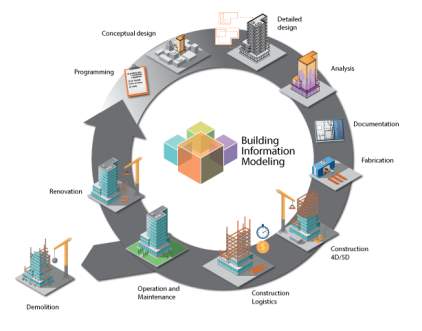
ABSTRACT
The UK Government has mandated the use of fully collaborative 3 dimensional Building Information Modelling (BIM) Level 2, in all Government projects by 2016 in the UK, however, literature identified some legal issues regarding this, which might stifle BIM implementation including, design responsibility issues, Copyrights issues, ownership of the data issues, intellectual property rights issues, security of information issues, format for exchange of information issues and possible future use of information issues.
A research study has been carried out to examine the risen legal issues using two phases. The first phase of data collection, was through an extensive literature review, data collected from recent UK based publications including books, Government publications, BIM seminars and BIM webinars, as well as, gathering data from documents published by the standards forms of contracts bodies on how to incorporate BIM into their existing contracts to cater for BIM maturity level 2. The second phase of data collection, carried out through conducting interviews with professionals in the UK construction industry. It has been found out the CIC BIM protocol and documents published by the standards forms of contracts bodies, have been rather successful to provide sufficient solutions to the risen legal issues.
Keywords: BIM, Legal issues, CIC BIM Protocol, Traditional forms of contracts, collaborative working.
Table of Contents
Abbreviations
3D 3-Dimensional
BEP BIM Execution Plans
CAD Computer Aided Design
CAM Computer Aided Manufacture
CIC Construction Industry Council
CD Clash Detection
CDE Common Data Environment
CDM Construction Design Management
CPD Central Procurement Directorate
DAC Design Automated by Computer
ECC Engineering and Construction Contract
ECS Engineering and Construction Subcontract
IFC Industrial Foundation Classes
IPR Intellectual Property Right
JCT Joint Contracts Tribunal
LOD Level of Detail
M.E.P Mechanical. Electrical. Plumbing
MPDT Model Production and Delivery Table
NBS National Building Specification
NEC New Engineering and Construction Contract
PAS Publicly Available Specification
PNG Procurement Guidance Note
PPC Public Procurement Contracts
PSC Professional Service Contract
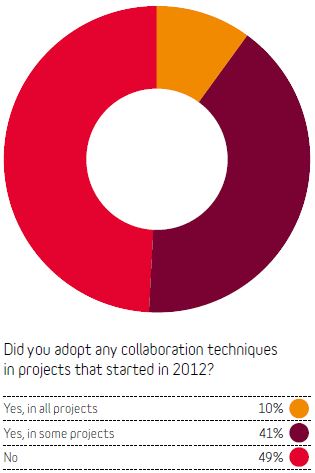
Figure 1.1.NBS National Construction Contracts and Law Survey 2013
Synopsis
NBS National Construction Contracts and Law Survey 2013
The survey carried out to study issues such as:
1. Procurement Routes.
2. Contracts, and how contracts are being used.
3. Legal issues encountered legal issues.
4. Disputes, nature of effects, and how participants resolve them.
The survey was carried on over 20 industry bodies, and over 1000 client, contractors, and consultants.
The purpose of the survey was to track changes in those areas, which will assist to predict how the industry will develop in the coming years.
The survey reveals that dispute remains an issue for the industry and it is still growing, with 30% of the participants have one or more disputes raised from a contract in the last 12 months, which is an increase by about 6% from previous year, 7% of the participants reported that they had been involved in three or more disputes.
The perception among participants in general, is that, the number of disputes are on the rise, with only 10% of participant disagreed with that.
Many of the surveyed disputes, involved large sum of money and have impacted severely on the construction process, half of the reported disputes, had value greater than £250,000, 13% had a value more than £5milion.
Overall, disputes arising from construction contracts appear to be on the rise according to NBS National Construction Contracts and Law Survey 2013, while at the same time, collaboration did not improve, with nearly half of the participant did not adopt any form of collaboration, although they were aware of its significance and agreed that, collaborative working would deliver client’s objectives better. Only 10% of the participants adopted collaborative working process in all their projects.
NBS National Construction Contracts and Law Survey 2015 finds that, disputes continue to blight construction industry
The study found out that, dispute is a real issue of everyday life in the construction industry, according to the 981 survey participants, value of final account and extension of time are the most common issues.
90% percent of the participants in this year thought that disputes has increased or remained at the same level.
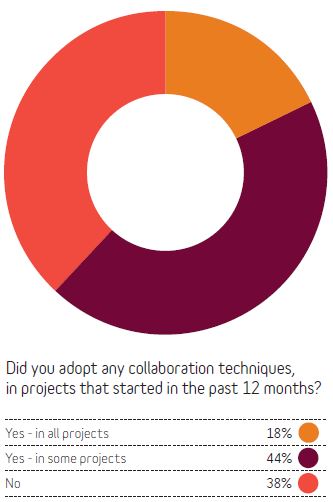
Figure 2.1. NBS National Construction Contracts and Law Survey 2015
Half of the participant stated that they dealt with at least one dispute in the last 12 months, most disputes occurred between clients and main contractors 76%, although suggestions made by Sir. Michael Latham in his famous report Constructing the Team, states that, If the construction industry is to become less adversarial, we must reexamine the construction process, particularly the relationship between contractor/subcontractor. (Latham,2014).
Collaboration has been improved in this year compared to the last survey, as 72% reported that, they have been involved in some collaborative working processes and 82% of the participants believed that working collaboratively has reduced disputes between contracting parties and in general collaboration has been improved when, the used contact was drafted to encourage mutual trust and incentivises all parties to work collaboratively.
Building Information Technology
Building information modeling (BIM) has been introduced to overcome many issues, one of them is to address the main issue of collaborative working, which is the clear definition of responsibilities, the report suggests that, the current used legal frames need to evolve, to contain and accommodate the changes BIM can bring.
Participants of the survey are members of more than 20 different industry bodies, who shared their experience in construction projects in the last 12 months, to provide overarching view of the construction industry.
Few such a research have been conducted previously, while the economic climate was different, however the result stated the same, the need for collaboration, the damaging effect of disputers and the adversarial nature of construction.
Legal issues in relation to BIM adoption in the UK
As part of the UK construction strategy, BIM level 2 mandate to all government projects in some parts of UK regions has raised some legal issues, which might stifle BIM implementation, including Model ownership, Integration of BIM into contractual arrangement, Design liability, as well as many additional issues, including Collaborative working and the Role of BIM coordinator. (Robert Eadie, Tim Mclernon and Adam Patton, 2015).
Origin of BIM
BIM is not new, the conceptual underpinning of BIM system started with the start of the concept of computer-aided design (CAD), which began in the 1950s and 1960s. The concept of BIM can be traced back to 1957 when Patrick J Hanratty, contributed to the CAD/CAM technology, when he developed a software for Pronto in 1961, he helped to develop the design of DAC (Design Automated by Computer), which was the first CAD/CAM system to interactive graphics.
At the same time, Ivan Sutherland in 1961, developed a CAD/CAM 3D system, Sketchpad “A Man-Machine Graphical Communication System”, on his Ph.D. thesis at Massachusetts Institute of Technology, the system allowed the designer to create components that can be stored, copied and reused. Contrary to the most of problem solving systems used at that time, which required the designer to instruct the system step by step to solve a problem, the designer in Sketchpad system, can investigate ideas to solve a problem collaboratively with the system, that the designer does not know precisely what the problem is nor how to solve the problem.

Figure 3.1. Douglas C Englebart’s paper “Augmenting
BIM as known today, was suggested as early as 1962, by Douglas C Englebert, when he published a paper titled “Augmenting the Human Intellect”, that paper contained examples of how advancement can be achieved in the architectural design process by connecting the advancement of computing technology to support a new way of working.
Following that, in September 1974 Eastman, published a paper named, an outline of the Building Descriptive System, outlining the design of a computer system which can process design information at a detailed level, allowing design construction and operation analysis to be carried out, the system named Building Description System (BDS), the system supports, “easy graphic entering”, editing, printout, and sorting of data such as material type, and supplier. It is not until about the 1986 and on a paper by Robert Aish where the initial documented use of the “Building Modelling” was used in the same modem sense of the acronym BIM (Laiserin citing Aish, 2008).
The need for change
Sir Michael Latham report Constructing the Team 1994, which was commissioned by the UK government and the UK construction industry to review procurements and contractual arrangements, the report recommended radical changes to the construction industry, as previous reports produced to improve the construction industry, have either been applied incompletely, or the problem have continued. The report emphasised that, the implementation of the recommendations begins with both public sector and private sector clients, a check list of design responsibilities should be prepared, the use of coordinated project information should be a contractual requirement and the role and duties of project managers requires to be more clearly defined, the report led to the establishment of the Construction Industry Board and legislation on adjudication and fair payments, in addition to many other radical recommendations, to improve the way the industry does business and to combat the adversarial culture of the industry.

Figure 4.1. The Latham Report, Constructing the Team
The mission of the report was, to assist UK construction industry to become internationally competitive, and to improve the quality of UK construction industry and reduce its average cost by 30%, and to introduce continues improvement programmes.
Following the success of Latham report, another vital report (Rethinking Construction by Sir John Egan) was issued by Construction Task Force, the report focused on the scope for improving the quality and efficiency of UK construction industry as the industry needs to modernise, to tackle many issues, such as, its profitability is unreliably low to sustain healthy development. The construction industry needs not only to do what it does better, but it needs to implement a radical change in the way it builds, by inviting the UK construction industry, the government, and major clients to foresee the needed changes.
Egan’s report recommended that, there is plenty of scope for improving efficiency and quality, simply by construction. The processes to deliver projects, shall be explicit and transparent to the industry and its clients. The report also stated that, the industry should create an integrated project processes around four key areas, Product development, Project implementation, Partnering the supply chain, and Production of components.
In terms of tendering the report recommended that, the industry should replace competitive tendering with long term relationship such as partnering, as contracts can considerably add to the cost of projects, and often add no value to the client, which should be based on measurement of performance.
The report endorsed substantial change to the industry culture and structure, which is needed to enable improvement, and to deliver the culture changes which are important to improve the project process, the UK construction industry must start by valuing its people, as they are the most valuable asset.
The report emphasised the importance of regulatory controls in construction to enhance quality and efficiency, however the interpretation and application of the regulations is inconsistent across the UK, making it more difficult to implement a construction project speedily and efficiently.
The Government View on BIM
The Government Construction Strategy (GCS), report was issues in May 2011, the report emphasised the importance of an efficient construction industry to the UK economy, with output about 7% of UK GDP, and public sector client being the biggest customer to the industry by spending total of 40%.
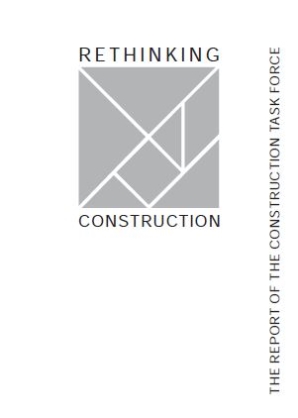
Figure 5.1. The Egan Report, Rethinking Construction
The report calls for profound change to the relationship between public authorities and the construction industry, to ensure that public authorities get a good deal and the country gets the social and economic infrastructure required.
The government released a detailed programme of measurements to reduce the costs by 20% by the end of 2011 parliament, the government announced that there is a need for change, as recent studies highlighted, key barriers to growth, such as, the construction sector under-performs in terms of capacity to deliver value in addition to lack of investment in construction efficiency and growth opportunities, poor and inconsistent procurement practices, predominantly in the public sector led to inefficiencies and waste.
One of the key strategic objectives of this report is the mandate of full collaborative 3D BIM (with all project and asset information, documentation and data being electronic) across government projects by 2016.
Cabinet Office, 2011 Government Construction Strategy
What is BIM?
There are several definitions of what BIM is, and in many ways, it depends on your point of view or what you seek to gain from the approach.
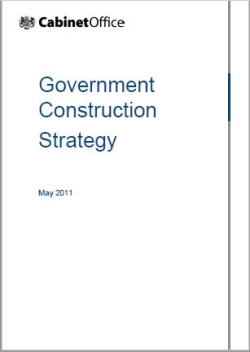
Figure 6.1. Government Construction Strategy May 2011
http://www.bimtaskgroup.org/bim-faqs/
BIM is not only a tool or a change of work technology, as all other technologies are recently developed technologically, BIM is a process which changes the way we design, build and maintain our buildings fundamentally by indicating the key physical and functional appearances of a building on a computerised prototypical form.
BIM is similarly, an acronym for Building Information Modelling. BIM describes how everyone can understand a building using a digital model which draws on a range of data assembled collaboratively, before, during, and after construction. Creating a digital Building Information Model enables those who interact with the building to optimize their actions, resulting in a greater whole life value for the asset.

Figure 7.1. Growth through BIM Richard G Saxon CBE
https://www.thenbs.com/knowledge/what-is-building-information-modelling-bim
UK Government Definition of BIM
Building Information Modelling (BIM) is a collaborative way of working, underpinned by the digital technologies which unlock more efficient methods of designing, creating, and maintaining our assets. BIM embeds key product and asset data and a 3-dimensional computer model that can be used for effective management of information throughout a project lifecycle – from earliest concept through to operation.
HM Government 2011
Levels of BIM
BIM is rapidly developing field, and there is no final definition yet of what BIM is or what it may develop to. Despite the debate of the definition of BIM, the industry has categorised BIM under various levels, the movement from level to more efficient level of BIM referred as “BIM maturity”.
Level 0
This level refers to unmanaged Computer Aided Design (CAD) in 2D drawings formed, primarily using lines, arcs, and texts, with output printed on papers, or on electronic data exchange forms, or mixture of both, this level is not a BIM as it known now, and there is no collaboration on it, it depends on 2D CAD system to design and to produce information.
Most of the UK construction firms, are well ahead over level 0.
(NBS National BIM Report 2014)
Level 1
This level mark the first step to genuine BIM and the use of 3D CAD for concept work in the design process, and 2D for the preparation of drawings for statutory approvals. The originator is usually operating in isolation, the collaboration among the originators happens when information exchange is needed in a central place named Common Data Environment (CDE), which normally complies with BS 1192:2007 (BSI, 2007), that set the code of practice for the collaborative production of architectural, engineering and construction information in the UK.
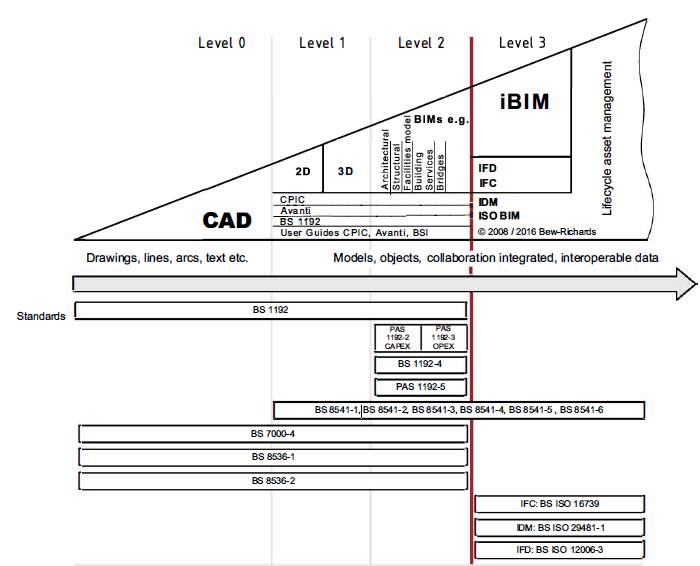
Figure 8.1. Bew-Richards maturity model
Level 2
This level is a managed 3D format, models are developed and held with the originators in a separate 3D BIM software, the collaboration comes on how the information can be exchanged between different parties, a significant characteristics of UK BIM Level 2, is the use of an ‘as – built data drop’ for the employer under a construction contract or professional service contract, the formalisation of this step established the need for agreed standards protocols and principles by which information can be created, shared, and exchanged.
Level 3
This level is also known as ‘Open BIM’, will be performance based, fully integrated and collaborative real-time project model, which would be enabled by web or cloud facilities. This level would solve interoperability issues as involved disciplines will work collaboratively in single model, which would result in fewer clashes, and less legal obstacles. This level of BIM will utilise 4D,5D and 6D dimensions and will be led by the development of standard libraries of objects.
(NBS National BIM Report 2014)
Design Liability and Ownership
What is design
Designs have been traditionally based on drawings and specifications, however when BIM is used as a tool for design, designers will face fundamental challenge to the way they approach design, because “with BIM, buildings are modeled rather than drawn”, (Comiskey, David, Tzortzopoulos, Patricia and Winnington, Mark (2014), citing levy 2012). The design process need to be more fluid and collaborative. Certain elements of the design, such as objects will be produced by other designers, various design team members may add to the model to produce flexible and fluid final design, the complete or partially complete design may store in cloud server, rather than the traditional methods, which bring certain challenges to the project parties.
In 2011 the UK government required fully collaborative 3D BIM approach to be adopted in all public funded projects, as a minimum by 2016 (Government Construction Strategy, May 2011). When BIM is adopted in a project and the adoption of BIM spreads further in the supply chain, the identity of the designer is not clear, in all cases there will be a party responsible for the design concept, who will maintain responsibility, however there will be other designers who will add to that design. All designers will now be ought to work together in collaborative way, that may arise many issues such as:
- Does the use of BIM changes the traditional provision of duties, between the client, designers, contractors and the suppliers?
- Do the standards committees that develop interoperability protocols and object specifications also become project designer?
- For how long designers would be liable for their designs?
- How traditional forms of appointments and contracts, can be amended to incorporate BIM?
- Is there any need for new forms of BIM contracts?
- Does the party managing the model undertake further accountabilities and risk?
The Designer’s Liability
In BIM level 2 working environment data and information are prepared and shared in 3-dimensional format and each 3D BIM model originator create and maintain their own model. The Government Construction Client Group (GCCG) stated that, the use of BIM level 2 does not necessitate huge change to the traditional forms of contract such as NEC3 and JCT, and it does not alter the provisions of tasks between the contracted parties, however, little change is needed in the copyright law, contracts, and insurance to facilitate working at Level 2 of BIM maturity, and simple new standard protocols and services schedules are needed to outline BIM-explicit roles, method of working and anticipated projects outputs.
Peter Barnes and Nigel Davies (2015) suggest that, in working with a collaborative BIM model many parties contribute to the to the design, however the use of BIM in the UK BIM level 2 setting, does not change the traditional provision of responsibility between the project party. In PAS 1192:2:2013 (BIM Task Group, 2013), advises that the lead designer shall be responsible for the harmonised delivery of the design information. The primary role of BIM level 2 information manager is, the management of information processes and compliance with agreed procedures and protocols in the common data environment (CDE).
Information Ownership
A dynamic BIM model raises issues around ownership, BIM model is vastly valuable but can be fragile, computer software is prone to power disruptions, viruses and physical damage.
An important element interlaced throughout the strategy vision of transformation to an optimised BIM model is the ability of all parties to communicate and collaborate freely. Current practices for silence for fear of liability must be eliminated.
(Peter Barnes and Nigel Davies, 2015).
Peter Barnes and Nigel Davies, 2015, stated that ownership of the BIM model is likely to be retained by the owner of the building, however ownership of the data which make that model itself, is a separate issue, information contained within a BIM model is highly likely to be contributions of different participants, for example, design data, cost data, graphical information, tables, and databases. Different legal findings may govern each of these rights. With regards to BIM intellectual property issues, they are like what existed traditionally before BIM, however, they are much augmented by the amount of data contained in the BIM model, as BIM model is a collaborative work, ownership of the data may not be vested in a single party, if ownership issues are significant, they should be determined by contract.
Arensman and Ozbek (2012) state that, on the question of who would own the model after completion of the project, the owner will want the BIM model, as they will need it to have a prototype of the final project and use it to manage the facility, the architect by law and custom, has intellectual rights to their BIM model, as it was their creation. According to Larson and Golden, lawyers with M.A. Mortenson, the legal principle is clear: ‘‘Absent contract language to the contrary, the party that creates the model owns it’’ (Larson& Golden, 2008, p. 22).
The study further highlighted that, typical BIM project will involve contributions from various parties, (Larson &Golden, 2008) suggest that, each of those information originators will want to ensure they own the model they contributed to. One apprehension each information originator can possibly have about the ownership is the repurposing of the BIM model and its data, by using the BIM model and its data for other projects or in ways not licensed by the owner of the intellectual property.
On the ownership of the BIM model issue and who is responsible of the data in the BIM model, (Owen, 2012) highlighted that, as a consultant taking from a project inception and depending on the procurement route, ownership and responsibility of the BIM model develops and changes, as the BIM model evolves and changes from conceptional stages to scheme stages, for example on design and build contracts, ownership and responsibility of the BIM model takes over to the Contractor rather than the actual design consultant, which is an evolution of the design process similar to what happen in normal contractual routes.
The effect of BIM on traditional forms of Contracts
Peter Barnes and Nigel Davies (2015), stated that, in the current used contracts, at BIM level 1, there are few issues in the contracts, as the BIM tools are commonly internal to members, this does not raise any need to alterations to the existing contract document, however, consideration should be taken to amend the existing forms of contracts, once BIM maturity level 2 is reached. Koko Udom (2012) stated that, because of the fundamental level of change that, comprehensive implementation of BIM Level 3 in the UK BIM maturity will bring at all levels, it is better to draft new forms of contracts.
The BIM Protocol
In February 2013, the Construction Industry Council (CIC) with the technical assistance and guidance provided by BIM Task Group, has issued the first edition of Building Information Model (BIM) Protocol, as part of its response to the UK Government BIM Strategy to improve traditional forms of appointments and contracts to include BIM at Level 2. The protocol identifies the required models to be produced by project team members, the protocol implies specific obligations, liabilities and associated limitations on the use of the models. BIM Protocol is drafted to maximise production efficiency and to define standards and best practices that ensure delivery of reliable quality data.
Legally, one of the BIM Protocol general principles is that, the Protocol drafted to be a contractual document, clause 2.1 of the BIM Protocol states: In event of conflict or inconsistency between the terms the CIC BIM Protocol and any other documents contained in and/or forming part of the contract, excluding cases where the CIC BIM Protocol states otherwise, the terms of CIC BIM Protocol shall prevail., this clear statement makes the BIM Protocol to take superiority over existing agreements. Every party involved in any use, or creation of the BIM models for a specific project, must have the same version of BIM Protocol appended to their contract, and every BIM project must have its specific BIM Protocol, this is due to the unique nature of construction projects. (Building information Model (BIM) Protocol, 2013)
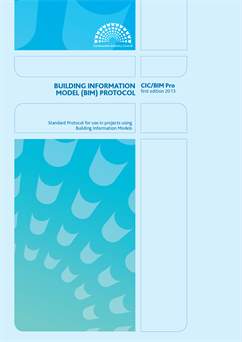
Figure 9.2. Building Information Model (BIM) Protocol, 2013
Amendment of Traditional Forms of Contracts
Public Procurement Contracts
CIC BIM Protocol has been issued to accompany Public Procurement Contracts (PPC2000), in response to the recommendations by the Government clients group, and the acceptance by the Government in May 2011 Construction Strategy.
The supplement contains set of an acceptable alternatives to incorporate CIC BIM Protocol into PPC2000 contracts so that (if so agreed):
- The lead designer of consultant service is to take the role of BIM-Coordinator
- The partnering time table and project time table (and any amendment to clause 8.3 and 8.6 in the project partnering agreement) incorporate all the inputs, timings and responsibilities that are contained in the BIM Protocol.
- 3D BIM model is to be included as part of the project proposal.
In addition, to many amendments that should be considered to the published forms of PPC2000, when the Project Partnering agreement is being filled out, to recognise the incorporation of BIM Protocol, BIM Protocol appendices and BIM-Coordinator as Partnering Documents. Refer to the appendices for the required amendments. (PPC2000 (Amendment 2008) Building Information Modelling (BIM) Supplement)
How to Use BIM with NEC3 Contracts
Dr Martin Barnes CBE, the originator of the NEC contracts stated that ‘the NEC does include specific provisions of for dispute avoidance. They are not necessary. Collaborative management itself is designed to avoid dispute and it really works.’.
In April 2013, the nec© 3 published a document on how to use BIM with NEC3 Contracts, to help contract compilers to incorporate BIM into NEC3, particularly in the main forms of NEC3 contracts, the document included a detailed guidance on how to use CIC BIM Protocol with NEC3.
The NEC 3 Contracts which are likely to be used in BIM Projects are:
- NEC3 Engineering and Construction Contract (ECC).
- NEC3 Engineering and Construction Subcontract (ECS).
- NEC3 Professional Service Contract (PSC).
The short versions of these contracts will not normally be suitable for the use in BIM Projects due to the additional risks and complexities that producing the BIM model adds to the process. Parties appointed in BIM project using short forms of these contracts may be required to provide their service in digital format, such requirements will be covered by provisions in the Work Information for ECC and ECS Contracts or Scope for PSC contracts.
NEC3 with CIC BIM Protocol
Each NEC3 Main contract form provide additional clauses which are likely to be used for preparing parts of the BIM model, those clauses should be stated as additional conditions of contract under option Z of respective contract, short forms of contracts should follow similar provisions to the main contracts. On the clauses where the CIC BIM Protocol modify the condition of NEC3 contracts or include information that form part of Work Information or Scope on (ECC) and (PSC) respectively, they need to be properly incorporated into the documents in order that, amendments can be instructed. The instruction then treated as compensation events. Definitions included in the BIM Protocol apply to the provision of the protocol only, and care should be taken where they may conflict with any definition stated in the Work Information or Scope. The CIC BIM Protocol stated in clause 2.1 that terms of protocol take priority over any other document, if the Project Manager or the Employer needed to issue an instruction to change the Work Information or Scope if it contains of any contradictory provisions. That instruction would be a compensation event.
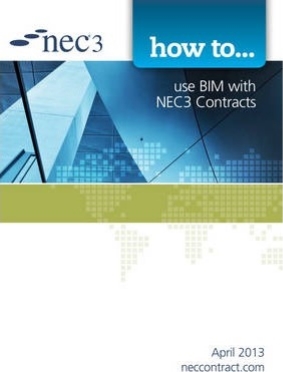
Figure 10.2. how to use BIM with NEC3 Contracts, 2013
Additional conditions, Work Information, Scope and Compensation events imposed by CIC BIM Protocol to NEC3 (ECC, ECS and PSC) Contracts, are showed in the following tables:
ECC additional clause
CIC BIM Protocol:
| 1 | In this clause, the Protocol is the CIC Building Information Modelling Protocol, first edition 2013.Terms used in this clause are those defined in the Protocol. |
| 2 | Clauses 1,2,5,6,7. Of the Protocol are additional conditions of contract. Clauses 3 and 4 and Appendices 1 and 2 of the protocol are Works Information. |
| 3 | The following are compensation events.
The Contractor encounters an event which is outside his reasonable control and which prevents him from carrying out the work specified in clause 4.1.2 of the Protocol. The Employer revokes a licence granted under clause 6.6 of the protocol. |
ECS additional clause
CIC BIM Protocol:
| 1 | In this clause, the Protocol is the CIC Building Information Modelling Protocol, first edition 2013.Terms used in this clause are those defined in the Protocol. |
| 2 | Clauses 1,2,5,6,7. Of the Protocol are additional conditions of Subcontract. Clauses 3 and 4 and Appendices 1 and 2 of the protocol are Subcontract Works Information. |
| 3 | The following are compensation events.
The Subcontractor encounters an event which is outside his reasonable control and which prevents him from carrying out the work specified in clause 4.1.2 of the Protocol. The Employer revokes a licence granted under clause 6.6 of the protocol. |
PSC additional clause
CIC BIM Protocol:
| 1 | In this clause, the Protocol is the CIC Building Information Modelling Protocol, first edition 2013.Terms used in this clause are those defined in the Protocol. |
| 2 | Clauses 1,2,5,6,7. Of the Protocol are additional conditions of Contract. Clauses 3 and 4 and Appendices 1 and 2 of the protocol are Scope. |
| 3 | The following are compensation events.
The Consultant encounters an event which is outside his reasonable control and which prevents him from carrying out the work specified in clause 4.1.2 of the Protocol. The Employer revokes a licence granted under clause 6.6 of the protocol. |
BIM in Joint Contracts Tribunal (JCT)
In 2011 the Joint Contracts Tribunal published a Public-Sector Supplement document to address some issues, most importantly for this investigation is Building Information Modelling.
The published paper included some steps that should be taken for all parties involved in the construction industry, the paper states that, if the project that intended to be delivered is governed by BIM Protocol, BIM Protocol shall be incorporated by the inclusion of it in the Preliminaries/Employer’s Requirements, or in any additional contract documents) and their harmonisation with procedures to submit designs, schedules to information and communication protocols. The Supplementary document explained in Part 3 and for Subcontracts and Sub-subcontract in Part 5 of the Supplementary document, how to incorporate those modifications. In Part 4 the document detailed the suggested modification to the various JCT Main Contracts. Refer to the Public-Sector Supplement for detailed information.
In 2016 the Joint Contracts Tribunal (JCT) published BIM Practice Note, which intended to asset in understating BIM. Paragraph 21 of the published document state that amendments required to any contract to consider the incorporation of BIM, should be looked at on an individual basis and care should be taken to avoid any conflict between contract provision and the selected BIM Protocol. However, perhaps the most significant point stated in the published practice note is that, the published note considers that contract provisions shall prevail in circumstances where there is a contradiction between contract provisions and the used BIM Protocol.
BIM Collaboration
The concept of collaboration is nothing new in the construction industry, traditionally master builders collaborating with workers and clients, to deliver their objective in the best way, long before the establishment of the current building professions. The change in collaboration are the new technologies available to designers and contractors, which in theory made the task of designing of a building much easier. (Stephen Emmitt and Kirti Ruikar, 2013).
In the UK, few number of government publications has been significantly important in raising awareness of the importance of effective working, Trust and Money (Latham, 1993) and Constructing the Team (Latham 1994), were strategically important reports on bringing collaborative working in attention. These reports were afterward strengthened by Rethinking Construction (Egan,1998), and Accelerating Change (Egan, 2002). One of the aims of Latham’s and Egan’s combined is to bring change to the construction industry from its adversarial nature to more trusting and integrated industry.
What is Collaborative Working
Working together in a unified team to joint objectives that bring benefit for all through commonly-beneficial alignment.
Collaborative team structure needs to be in place, to get the best result of the available technology such as BIM, the structure of the relationship between team members would either be in form of contract or in form of agreed way of work, in this structure team members will provide each other with the defined information, which would allow team members to carry out their tasks in the best way in the BIM model. (Peter Barnes and Nigel Davies, 2015). CIC BIM Protocol had been issued in 2013, to provide detailed information on enabling the production of information models to support collaborative working, when it is adopted to a collaborative team structure. (BIM Protocol, 2013).
Collaboration through BIM creates great opportunities; however, it also creates new legal and liability issues. (Peter Barnes and Nigel Davies, 2015).
Investigation Findings
This chapter summarises the findings obtained from the investigation into the risen legal issues relating to the implementation of BIM level 2 in the UK construction industry through extensive literature review.
- Design a project using BIM level 2 has changed from the traditional way to approach designs, with BIM buildings are modelled rather than drawn.
- In working with a collaborative BIM level 2 model, many projects parties add to the design, however, that, does not alter the traditional provisions of tasks between the project parties.
- Ownership and responsibility of the BIM model develop and change as the model evolves and change as the model evolves from conceptual stages to scheme stage for example on design and build ownership and responsibility of the model takes over to the Contractor rather than the consultant. However as built BIM model is likely to be taken by the project owner. Information within the model is likely to be vested with the originator, unless another agreement state otherwise.
- Intellectual property rights of an originator are protected as it was traditionally, Intellectual property rights are “automatic” rights, anything unique that an originator created, which meet the requirements to be protected as an intellectual property right, will be protected.
- Amendment to the traditional forms of contracts is sufficient to satisfy the changes that BIM maturity level 2, brought to the UK construction industry.
Due to the huge changes that BIM maturity level 3 will bring, it is likely that, new forms of contract will emerge.
- The CIC BIM protocol is drafted to satisfy the need for amendments of the existing forms of contracts to cater for BIM maturity level 2. The CIC BIM protocol has gone a long way to address the legal issues raised at BIM maturity level 2.
- The Public Procurement Contracts (PPC2000) has issued a detailed document to cater for BIM in response to BIM maturity level 2 as part of the UK construction strategy 2011. Further details on the required amendments to the (PPC200) contracts, can be found in chapter 0000 and on the appendices 0000000.
- NEC published a detailed document on “how to use BIM with NEC3 Contracts”, to guide contract compilers to integrate BIM into the NEC3 contracts, especially the main forms of NEC3 contracts. Further details on the required amendments to the (NEC3 main contracts), can be found in chapter 0000and on the appendices 0000000.
- The Joint Contracts Tribunal (JCT) published a document “Public Sector Supplement” that contained steps on how to incorporate BIM protocol into their contracts, Further details on the required steps to incorporate BIM protocol into JCT contracts, can be found in chapter 0000 and on the appendices 0000000.
- Collaborative working is nothing new, the change in collaboration is the new technologies, which made task of design and build easier. Few strategic government publications have raised the importance of effective collaborative working, aims in collaborative working are to bring the UK construction industry from its adversarial nature to more integrated trusting industry for the benefit of all participants in the construction industry.
Comparable Research
Few interviews were conducted, with some BIM experts from academia and policy makers, those interviewees are expert, particularly around the field of procurement in the UK.
The interviews were intended to investigate 9 main questions, response to the questions were summarised, and analysed in the following pages, full transcriptions of the conversation can be found in the appendices.
The investigation core questions included:
- What do you think the legal issues which have risen due to the implementation of BIM in the UK construction strategy would be?
- Regarding the risen legal issues, are there any benefits or drawbacks to the implementation of BIM in UK?
- How does BIM change the traditional allocation of responsibilities between Clients, designers, and contractors? If there any.
- Is there any benefits or drawbacks of the use of CIC BIM Protocol in Government Projects?
- Does the standard committee that develop protocols become a project party that should be responsible and liable for any failure?
- Does the party managing the model undertake further accountabilities and risk?
- How traditional forms of appointments and contracts, can be amended to incorporate BIM?
- Is there any need for new forms of BIM contracts?
Interview Number One
Robert
Robert is a course director of the MSc Infrastructure Engineering Course and he is the Interim Academic lead for Civil Engineering. Robert has been involved in the implementation of BIM within the Civil Engineering Discipline.
- What do you think of the legal issues which have risen in the construction industry in UK due to the implementation of BIM in general?
- At Level 2 I don’t think that there have been many legal issues that have arisen. This is due to accurate and extensive documentation for example the PAS documentation and the CIC protocol which stipulate the responsibilities of each of the parties
- Difficulty will arise when Level 3 is implemented with everyone working on a single model.
- Are there any benefits or obstacles, which will impact on the UK construction strategy, created by the legal issues?
- Not as far as structure is concerned.
- However, there are issues relating to formats for exchange of information. For example, I have carried out research into interoperability which has shown that IFC’s are not as reliable as they should be for exchanging models, during that research I have been shown examples of doors which have swung the opposite way after import. This causes issues as the correct information left the originator but software glitches caused the information to be incorrect on import
- Does BIM change the traditional allocation of responsibilities between Clients, designers, and contractors?
- No until everyone starts working on the same model.
- Do the standards committees that develop interoperability protocols and object specifications also become a project party? that should responsible and liable of any failure?
- No, it is up to users to amend documents as they see fit.
- Does the party managing the model undertake further accountabilities and risk?
- The BIM manager has a number of responsibilities but is not allowed to amend separate models in Level 2. At Level 3 it is likely that the BIM manager role will disappear according to recent research.
- Is the use of CIC BIM Protocol compulsory for Government Projects?
- In Northern Ireland, the CIC BIM Protocol is set alongside other documentation and operates in a slightly different way than in the rest of the UK.
- How traditional forms of appointments and contracts, can be amended to incorporate BIM?
- Standard NEC3 contracts can be amended using Z Clauses to incorporate the BIM.
- In Northern Ireland, standard Z Clauses have been developed by CPD to do this.
- For Government work in Northern Ireland the NEC3 conditions are mandatory. Therefore, the issue relating to JCT will not arise.
- Is there any need for new forms of BIM contracts?
No. The NEC3 suite with the amendments is sufficient.
Interview Number Two
Michael
Michael works for the Northern Ireland Central Procurement Directive (CPD), in the construction procurement policy branch, Michael works for the (CPD) in the construction unit, Devising policies to help the delivery of public sector projects, to get the best value for money from those projects. He developed the procurement guidance note (PGN 03/15 – Building Information Modelling (BIM)) for the delivery of BIM in the public sector in Northern Ireland, and he also, developed employers’ information requirements templates for government departments, Michael lead the government BIM task and finish group within NI, and sits on the NI BIM regions steering group.
- What do you think the legal issues which have risen due to the implementation of BIM in the UK construction strategy would be?
- There are several aspects to that, there’s the copyright issues.
- There are the intellectual property rights issues.
- There are Ownership of the data issues.
- there’s also the design responsibility tying in with their professional indemnity insurance.
- Regarding the risen legal issues, are there any benefits or drawbacks to the implementation of BIM in UK?
- The protocol is a benefit; it has been well considered and it goes a long way to address a lot of the issues that the industry has.
- Another big benefit of the BIM process is that; you have greater coordination of the project.
- The drawback, is on the client side, the client must get around ownership issues and must become more familiar with licensing.
- How does BIM change the traditional allocation of responsibilities between Clients, designers, and contractors? If there any.
- It changes responsibilities to a certain extent, but not huge change, everyone has his role within the BIM process and that need to be understood.
- In the delivery of the BIM project the client probably has the furthest to travel in terms of knowledge and understanding.
- The M&E engineers, mechanical, electrical, and plumbing engineers M.E.P. I think they have a good distance to travel as well.
- contractors still build the building but I think they have some distance to travel to in the sense that, they need to become familiar with, how to work with the digital technology in a better way.
- Is there any benefits or drawbacks of the use of CIC BIM Protocol in Government Projects?
- Government traditionally would have taken the position to own information that handed over from the delivery teams.
- Due to the BIM protocol, government currently shares information with the parties involved in the delivery of a project for the purpose of delivery.
- Due to concerns around future extensions and alterations of a project, you will probably see in the future either a move from government to say we own the data which will revert to its traditional position or government would agree to share it but we will also require the information for the whole lifecycle of the project.
- Does the standard committee that develop protocols become a project party that should be responsible and liable for any failure?
- I don’t think it is necessary for the Committee to have a legal responsibly or to be legally liable for the use of its protocol, I think liability sits with the employer.
- It is up to the employer in this case government department to satisfy itself, that its contractual requirements are right.
- I think the protocol is there as a guide and it’s taken now to be best practice.
- Does the party managing the model undertake further accountabilities and risk?
- If we start with the designers, each discipline within the design team has their own requirements to produce their own discipline model.
- They will have their own office requirements for managing that data and for managing their design.
- They will have professional indemnity insurance to cover their design.
- In Northern Ireland, the contract that goes out of government departments is asking the supply side, the designers, to provide a common data environment.
- The lead consultant usually is the person to take on the procurement of the common data environment, and he/she will often be providing the required rules for information management.
- The company that takes on the rule of providing Common Data Environment (CDE), should be satisfying themselves that, the software that they have chosen should not only meet the specifications of the contract, but also, that they have some sort of sub service level agreement with the provider of the common data environment for backup of information, loss of data, and corruption of data, because they will be dealing with their own data and everyone else’s.
- How traditional forms of appointments and contracts, can be amended to incorporate BIM?
- Government in Northern Ireland uses NEC3 forms of contract.
- How to work with BIM in the NEC3 guidance note basically says that, you append the CIC BIM protocol to the contract and a certain number of clauses within the protocol are Contract data and other clauses are works information.
- I think that the protocol can be appended easily to the NEC3.
- In Northern Ireland, we do that using an optional Z clause, Z26.
- All of BIM project will select clause 26 which will say that the CIC BIM protocol is appended to this contract, BIM protocol then takes precedence over copyright rights, intellectual property rights, who owns the data, and the model taking precedence.
- Government in Northern Ireland doesn’t use J.C.T. contracts.
- Is there any need for new forms of BIM contracts?
- NEC4 is going to be released in June this year, it’s all based on collaborative working practices.
- A lot of the ideologies in the BIM process, has been brought in the new NEC4 contract.
- The best contract for work with BIM, is any contract that promotes partnering, collaboration, and good contract management process all the way through.
- The NEC3 suits of contracts goes toward that way of working.
- As the BIM process becomes more common place all contracts will begin to adopt it in this part of a way of working.
Interview Number Three
Mark
Mark, is the Course Director for the BSc (Hons) Quantity Surveying & Commercial Management full-time program, and he is also a lecturer in Quantity Surveying. Mark is a current member of NI BIM regions steering group.
- What do you think the legal issues which have risen due to the implementation of BIM in the UK construction strategy would be?
- BIM must be embraced in all levels of construction disciplines, because of its benefits, however, that will bring some changes, those changes must be embraced as well, such as, the way we procure and the way we enter our contracts.
- The level of information shared in BIM, rises issues of security of information, copy rights, liability, and future use of information for extension for instance.
- Regarding the risen legal issues, are there any benefits or drawbacks to the implementation of BIM in UK?
- The CIC BIM protocol is one of the good thought of benefits, to address those legal issues.
- I am not aware of any drawbacks.
- How does BIM change the traditional allocation of responsibilities between Clients, designers, and contractors? If there any.
- In BIM level 2, the traditional allocation of responsibilities does not change.
- When parties start to work in the same model in level 3, the traditional allocation of responsibilities are likely to change.
- Unless a BIM test case arises, it is difficult to give a definitive answer.
- Is there any benefits or drawbacks of the use of CIC BIM Protocol in Government Projects?
- I am not aware of that.
- Does the standard committee that develop protocols become a project party that should be responsible and liable for any failure?
- I do not think so, because for instance you cannot act against J.C.T for any failure.
- it is up to you to design your contractual arrangement.
- Does the party managing the model undertake further accountabilities and risk?
- The party who manages the model is covered by professional indemnity insurance.
- How traditional forms of appointments and contracts, can be amended to incorporate BIM?
- Any agreed BIM Protocol can be incorporated into J.C.T. as a contract document, which will force the contracted parties to comply with that document.
- NEC3 published a detailed document “how to use BIM with NEC3 contracts” to explain how NEC3 contracts can be amended to incorporate BIM.
- Is there any need for new forms of BIM contracts?
- NEC3 and JCT, have published detailed supplements on how to incorporate BIM to their contracts.
- New NEC4 complete forms of contracts are about to be released this June, new contracts use clear and proficient language to promote fair dealing, and more certainty to avert litigation, even on complex projects.
Comparable Research Findings
Interviewees stated that, some legal issues have risen in the UK construction industry due to the implementations of BIM, the risen legal issues are, design responsibility issues, Copyrights issues, ownership of the data issues, intellectual property rights issues, security of information issues, format for exchange of information issues such as (IFC), and any possible future use of information issues.
One of the biggest benefits of the BIM level 2 risen legal issues is the CIC BIM Protocol, another benefit is the emerge of BIM level 2 process, which has given greater coordination to the project. The drawback is, on the side of the client, the client must get around ownership issues and be more familiar with licencing.
The traditional allocations of responsibilities between the construction project parties, have not changed, however, the expected level of standards, of what a reasonable practitioner should know and should do, may increase due to the use of BIM.
Standard committees that develop protocols and standards, such as CIC will not be liable for any failure due to the use of their documents.
The further risks and accountabilities which will be undertaken by the party who manages the BIM model, will be covered by the party professional indemnity insurances.
Traditional forms of contracts can be amended to incorporate BIM, in the NEC3 suite of contracts, BIM can be appended using clause Z, Z26, clause Z26, then will state that, BIM protocol is appended to the contract, subsequently the used BIM protocol takes precedence over existing arrangement. In JCT suite of contracts, any agreed BIM protocol can be incorporated into JCT contracts as a contract document, which will force contracted parties to comply with that document. NEC3 and JCT have published detailed documents on how to incorporate BIM into their contracts.
The is no need for new BIM contracts, The NEC3 suite and JCT with their amendments are sufficient for now, however, NEC4 suite of contracts is going to be released this June, and it is based around the importance of the programme.
Discussion
Designing a project utilizing BIM level 2 principles, have changed the traditional methods to approach designs dramatically, as project parties contribute collaboratively to the design process of a project using 3D BIM models to deliver client’s need, contrary to the traditional method using 2D drawings. Theoretically the input of the client in the BIM design process stayed at the same level as it was traditionally, Michael Mclernon stated that, when he tries to describe BIM to people, BIM creates more informed brief for delivery teams and the client must create that more informed brief.
The client probably has the furthest to travel in terms of knowledge and understanding, if the client can set out very clear requirements through the employer’s information requirements, by getting his departments to outline their asset information requirements and organisational information requirements, that will establish a very concise brief to deliver upon. M&E consultants and Contractors, should also have to become more familiar with the available 3D BIM technology and processes, as they have been traditionally working more in 2D environment, Designers and Structural consultant have always worked in 3D environment, however, they should look at the BIM maturity level 2 process.
The change that BIM maturity level brought, raised some legal concerns, interviewees highlighted that, the following issues were the risen legal issues regarding, BIM maturity level 2, design responsibility, Copyrights, ownership of the data, intellectual property rights, security of information, format for exchange of information and possible future use of information are the actual issues.
In working with a collaborative BIM maturity level 2 model, traditional allocations of responsibilities, does not change between the project stake holders, however it develops and change as the BIM model evolves from conceptual stages to handover stages, Robert Eadie stated that, in BIM maturity Level 2, information provided by all the parties involved can be viewed legally in the same way as the design information provided on 2D drawing. Mark McKane stated that, when parties start to work in the same model in BIM maturity level 3, the traditional allocation of responsibilities are likely to change. Michael Mclernon highlighted the point that, it is only a process change.
Theoretically, the duty of care is that, the legal obligations that you must ensure that, your actions and your omissions do not cause harm to someone else within that duty of care, there is a threshold to judge you on how good or bad your actions or omissions are, the standards are, the standards of a reasonable practitioner of a service or of a particular scope of work, the law does not say designers, or contractors, or anybody is perfect, however project participant have to be reasonable, for example, reasonable within the arrival of BIM, therefore BIM does not change the duty of care.
Project participants are still liable for their actions and omissions, however the standard threshold of what a reasonable practitioner should know and should do, or should not do in each circumstance, may increase, because BIM gives greater certainty to the design and construction teams contrary to the conventional 2D working environment. Although there is no legal case in the UK to give a clear view on this pint.
(Rob Owen, 2012) stated that, ownership of the BIM model develops and change, as the model evolves and change, as the model evolves from conceptual stages to scheme stages for example on design and build contracts, ownership of the BIM model takes over to the Contractor rather than the consultant, however as built BIM model is likely to be taken by the project owner. Michael Mclernon, mentioned that, Government in Northern Ireland traditionally would have taken the position to own the licence of the data that handed over from the delivery teams, due to the requirement of the BIM protocol to share the information for the delivery of a project, government now shares the licence with project parties, however, the government current position might change, due to concerns regarding possible future use of the data for extensions for instance.
The position of BIM protocol is, any rights remain with the originator and if a project owner wants to own all the project intellectual property, the CIC BIM protocol must be corrected and additional change to the agreements may be needed. Most of the collected data sources in this investigation would agree that, as build model is likely to be ownership of the project owner to manage the facility, however, information within the model is likely to be retained with the originator, unless another agreement state otherwise.
Intellectual property rights of any originator are protected by law as it was in the traditional setting, intellectual property rights are “automatic” rights, anything unique that an originator created, which meet the requirements to be protected by the law as an intellectual property right, will be protected. An Idea of a design for example does not meet the requirements of protection by IPR law, unless that design idea has been physically documented, IPR can be bought from the creator or from previous owner.
Many professionals in the construction industry believe that, the existing forms of contracts with some amendments are sufficient to satisfy the required changes to facilitate CIC BIM protocol to cater for BIM maturity level 2. The CIC BIM protocol is drafted to satisfy the needed amendments to the existing forms of contracts. The CIC BIM protocol clauses, then take precedence over existing arrangement, liability of the use of the CIC BIM protocol sits with the employer in case of any failure, due to the use of protocol, Michael Mclernon highlighted that, the protocol is there as a guide and it is there to be best practice.
Some of the existing forms of contracts are collaborative in nature, the NEC3 contracts for example are based on mutual trust and respect, this is the first clause on the NEC3 suite of contracts. Michael Mclernon also stated that, the NEC3 requires the client and the designer, or the client and the contractor to work closer together in the delivery of the project, therefore, BIM fits with that process in that BIM is all about Collaboration.
Michael Mclernon added that, the best contract for work with BIM would be, any contract that promotes partnering, collaboration, and good contract management process, all the way through. Government in Northern Ireland uses NEC3 forms of contracts to procure its need. Robert Eadie highlighted that, in Northern Ireland standard Z Clauses have been developed by CPD to incorporate BIM, and for Government work in Northern Ireland the NEC3 conditions are mandatory.
The NEC3 has published a detailed document on “how to use BIM with NEC3 Contracts”, NEC3 suite of contracts are the most suitable contracts to cater for BIM as these contracts are based on similar approaches to what BIM is intended to deliver to the UK construction industry. such as collaborative working, good management, and greater integration.
The Public Procurement Contracts (PPC2000) which was first published by John Egan in 2000, who described it as “a blow for freedom”. has issued a detailed document to cater for BIM in response to BIM maturity level 2 as part of the UK construction strategy 2011, these contracts basic characteristics are to provide a foundation and route map for the partnering process in any partnered project.
Public Sector Supplement was issued by J.C.T, which allows the employer to procure regarding BIM, the steps to incorporate BIM are basically based on, any agreed BIM Protocol can be incorporated into J.C.T. as a contract document, which will force the contracted parties to comply with protocol. J.C.T have published BIM Practice Note in 2016, in paragraph 21 it states that, contract provisions shall prevail in situations where there is a contradiction between contract provisions and the used BIM Protocol.
This statement might not allow protocols such as CIC BIM protocol to cater for that contract. Government in Northern Ireland does not use J.C.T. contracts but it would have in the past used the Government’s works contracts which was mostly based on J.C.T. Michael Mclernon, stated that, based on his research, the J.C.T forms does not necessarily make as much reference to BIM, it is not as considered as NEC3.
More strategic publications and trainings on the importance of collaborative working practices will raise more needed awareness of the UK construction industry steak holders, of the benefits which can be obtained from effective collaborative working by encouraging project steak holder to adopt forms of contracts which encourage mutual trust and incentivises all project parties to work collaboratively. Although the level of collaborative working between contracting parties in the UK construction industry have been increasing slightly in the past few years according to NBS National Construction Contracts and Law Surveys, however disputes are at the same level or have been increasing slightly.
Conclusion and Recommendations
The discussion around the legal issues which have risen due to the implementation of BIM maturity level 2, in the UK construction industry is continuing, the Government in Northern Ireland might change its current position regarding ownership of the handed data, due to a future concerns of the possible use of that data. The literature has identified that, it is unlikely to get a definitive answer or a solution to some of the risen legal issues until has been a legal test case, however and due to extensive and considerable discussion between the UK Government and the industry boards to resolve a lot of the risen issues, accurate and extensive documents such as the CIC BIM Protocol and PAS documents emerged to address many of the risen issues by specifying responsibilities of each party successfully.
Both interviewees and literature revealed that, existing forms of contracts with some additional amendments are sufficient to cater for BIM maturity level 2, although, some contracts which encourage partnering and collaborative approach toward achieving common objective are easier to work with and better to cater for BIM maturity level 2, nevertheless, understanding your obligations and liabilities within a contract in addition to, the required level of detail (LOD), BIM Execution Plans (BEP) and Model Production and Delivery Tables (MPDT) within any contract before procurement, is a vital element toward delivering a successful project.
The possibilities of BIM are endless, the trend in the construction industry is, when there is something new, people immediately want to assign more risk to it, that seems over now, at least for BIM, Lloyds of London is started to offer accreditation for BIM Level 2 compliance, with a range of accompanied benefits, they saw that as, it will be more beneficial to their company’s Professional Indemnity Insurance premiums. A project with the right experienced team members should account for lower premium costs because, they will deliver better collaboration and better management to the design process therefore better risk management which will eliminate the potential for any insurance claim.
Some raised or noticed issues during data collection phases need to be highlighted, more focused training and workshops about specific areas for a particular profession is needed, for people who involved in delivering BIM. Targeted trainings for professionals such as, lawyers, contractors, M&E engineers, in general is required, to form a link between old and new, law and technology, for instance people who lead organisation tend to be not the ones who are up to date with technology, and the legal profession is not normally the one that lead on technological issues.
Cite This Work
To export a reference to this article please select a referencing stye below:
Related Services
View allRelated Content
All TagsContent relating to: "Construction Law"
Construction law concerns the legal practice of dealing with matters related to construction projects, infrastructure, engineering, and related fields. Construction law includes elements of contract law, commercial law, planning law, employment law and tort.
Related Articles
DMCA / Removal Request
If you are the original writer of this dissertation and no longer wish to have your work published on the UKDiss.com website then please:




